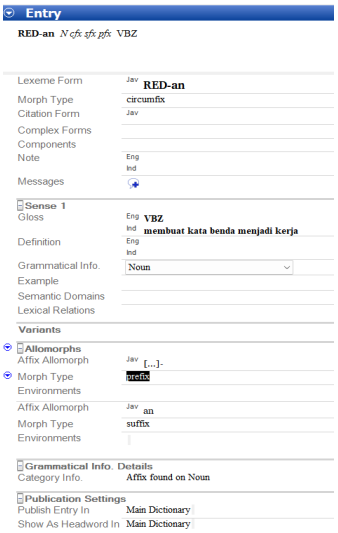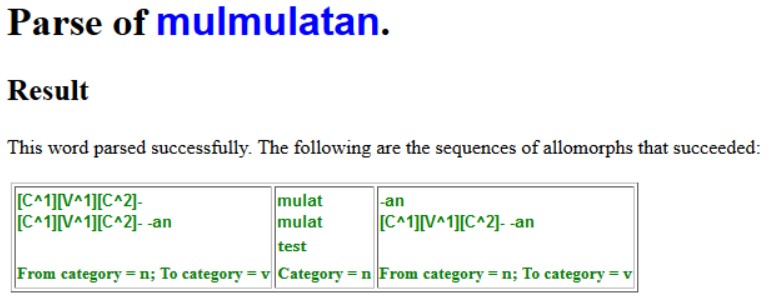Combination of reduplication and circumfix (XAmple)
47 views
Skip to first unread message
Daniel Krauße
Oct 29, 2023, 1:18:17 PM10/29/23
to FLEx list
Hi all,
I have the following pattern:
- bal-balan < bal
- mur-muran < mur
- dang-dangan < dang
This means that the base word is reduplicated and the suffix -an is added to the reduplicated word, basically it is a circumfix RED-...-an. I have been using XAmple for this project, so I'm hoping that the pattern above can also be implemented with XAmple. I've tried it as in the attached picture, but it doesn't work. General reduplication like bal-bal works fine in the same project.
Thanks in advance!
Best,
Daniel

julius
Oct 30, 2023, 2:46:09 AM10/30/23
to FLEx list
Hi Daniel,
I think your main problem here is with the reduplication and how to tell FLEx what to look for. From your screenshot I can see "[...]" down in the affixes where there should be a reduplication pattern such as [C^1][V^1][C^2]. More information on Reduplication and its patterns can be found in the FLEx Resources under Help > Resources > Introduction to Parsing > 3.2 Reduplication.
When I tried replicating the example in my test project it parsed with the following setup.

Depending on other factors it might need some more tweaking in your case, but then we would need more information.
Julius
Daniel Krauße
Oct 30, 2023, 7:00:17 AM10/30/23
to FLEx list
Hi Julius,
Thank you very much for your response. Your pattern works fine! I had to add the hyphen to get things like mur-muran, but that is good now. Although I had thought that there was a way to use the pattern for full reduplication "[...]" because ususally those words are reduplicated in their full form, so your ex. "mulat" would reduplicate as mulat-mulatan, not mulmulatan. I have now added a reduplication pattern for each syllable structure but I find that solution a bit cumbersome when it's clearly just full reduplication + -an.
Best,
Daniel
julius
Oct 30, 2023, 7:39:08 AM10/30/23
to FLEx list
Hi Daniel,
I will have to apologise as I have misread your initial request and was to hasty. I did run into the same problem and could unfortunately not find a solution. So maybe someone smarter can figure it out... I tried seevral other approaches but ultimately failed to find a solution to the problem you posed in the first post.
The interim solution could be something along the lines, but since it actually is full reduplication and there is a special sign for that, the [...] I so hastily pointed out, there should be something. I just don't know how to do it.
The interim solution could be something along the lines, but since it actually is full reduplication and there is a special sign for that, the [...] I so hastily pointed out, there should be something. I just don't know how to do it.
Julius
julius
Oct 30, 2023, 7:48:29 AM10/30/23
to FLEx list
I went back into the help document and there is one little element in there:
"Determine that the reduplication is indeed full reduplication. Note that if both prefixes and suffixes attach to a reduplicated sequence, then you will need to use partial reduplication (see section 3.2.2)"(I added bold for clearance)
So I guess there is no easier solution, unless someone else has a better proposal.
Julius
SM
Oct 30, 2023, 7:28:06 PM10/30/23
to FLEx list
Hi Daniel
In the Introduction to Parsing documentation (found in FLEx from Help / Resources), in section 3.2.1 it says (bold mine):
Notice the ‑nya suffix which comes after the reduplicated stem. The way we are modeling full reduplication in FieldWorks Language Explorer, the root must be at one end and then any affixes (including the reduplication morpheme) must either be all prefixes or be all suffixes.[47] Thus, in modeling examples (110)‑(111), we would make the reduplication morpheme be a suffix.
-------
Thus, I think that you cannot use a circumfix, but you need to consider if the reduplication can be considered to be a suffix, and then the root will be first, followed by the two suffixes (reduplication and the -an).
Sara
Daniel Krauße
Nov 2, 2023, 11:06:44 AM11/2/23
to FLEx list
Dear Sara,
That was exactly what I was looking for! In fact, I've redefined the reduplication pattern so that it is now a suffix. That allows me to add more suffixes after the reduplication, great! Thanks a lot for your help.
Best,
Daniel
Reply all
Reply to author
Forward
0 new messages
